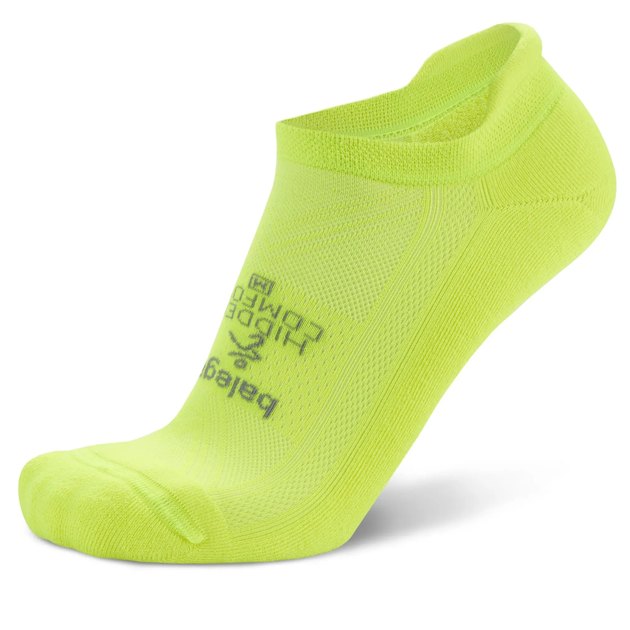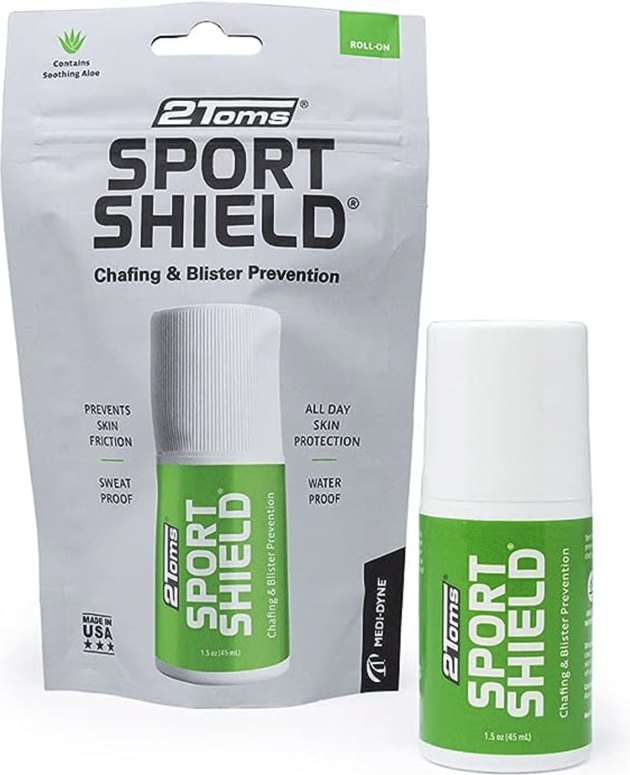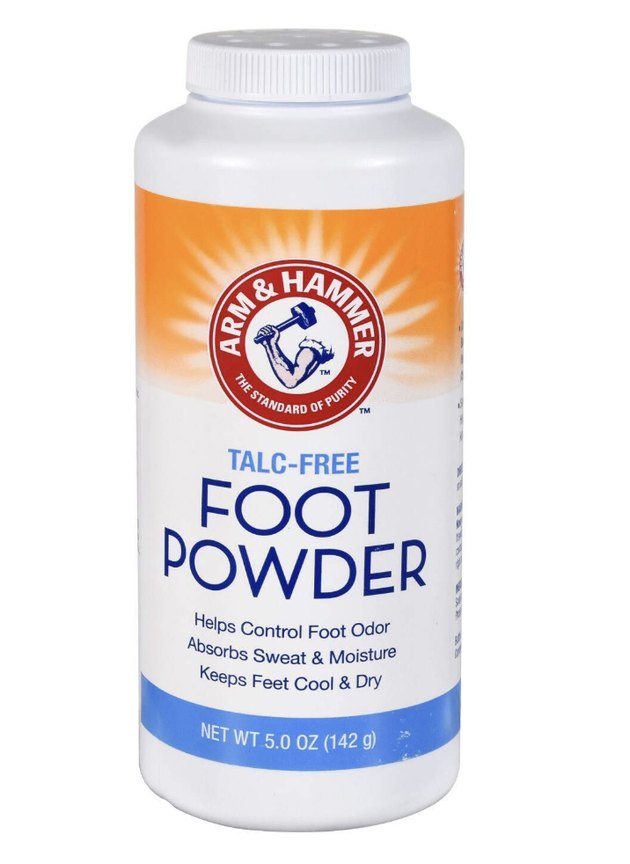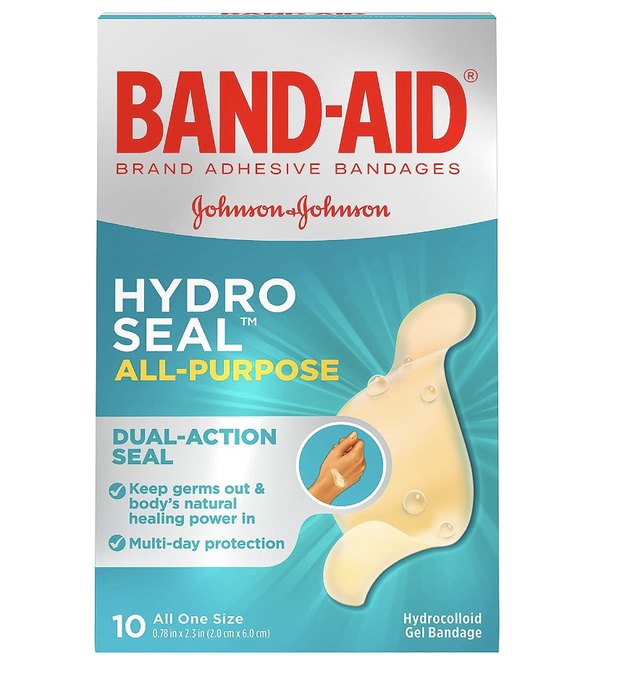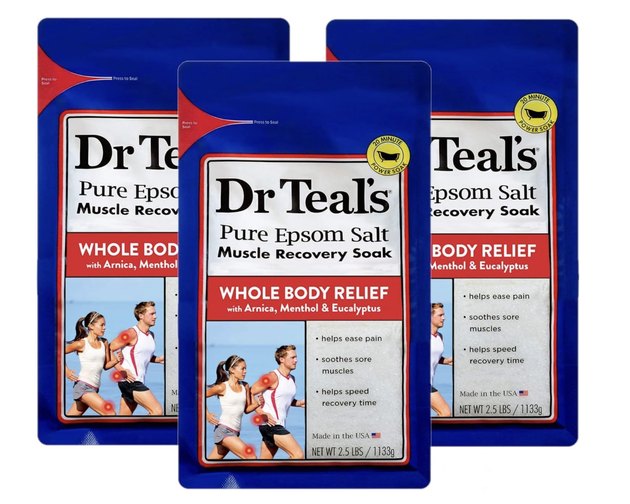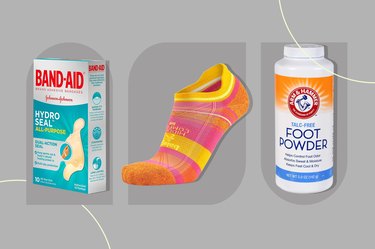
Blisters run the gamut from being minor hot spots on your foot to major ailments that affect your ability to comfortably stand on two feet. And no one is immune — even professional athletes get blisters every now and again.
To help you deal with (and avoid) the pain, we've gathered the best, expert-approved products to treat and prevent even the worst running-related blisters.
Video of the Day
Video of the Day
The Best Blister Products
- Best Shoe: Hoka Bondi 8 ($165, REI)
- Best Socks: Balega Hidden Comfort ($15.99, Amazon)
- Best for Chafing: 2Toms Sport Shield ($15.99, Amazon)
- Best for Moisture Prevention: Arm & Hammer Foot Powder ($7.85, Amazon)
- Best for Hot Spot Prevention: Band-Aid Hydro Seal Bandages ($5.79, Amazon)
- Best for Relief: Dr. Teal's Epsom Salt - Muscle Recovery Soak ($19.99, Amazon)
How We Chose
We spoke with podiatrist Miguel Cunha, MD, a New York-based podiatrist with Gotham Footcare to help us nail down the absolute best blister care products. With his guidance, we chose these products, based on factors including:
- Cost
- Product variety
- Movement-friendliness
For more information on how we choose and cover products, click here.
A Note on Language
We make deliberate choices about the language we use but manufacturers tend to market products to men and women. The specific gender terms below match the marketers' original language. However, the main difference between most men's and women's shoes lies in the shoe width and size. In some cases, men's shoes are built to support greater weights. So people with bigger bodies may want to opt for men's versions people with smaller bodies may prefer women's versions.
1. Hoka Bondi 8
One of Hoka's highest-cushioned running shoes, the Bondi 8 is among the best sneakers for blister prevention. As the Bondi 8 comes in larger widths, it helps decrease the likelihood of toe friction while running (a big blister cause). Even if you don't need a wider width shoe, wider toe boxes are ideal for keeping blisters at bay, according to Dr. Cunha.
This shoe is so roomy, you can comfortably wear it with Band-Aids or thick socks if you're dealing with pre-existing blisters. It's even a great choice for other foot issues, including hammertoe.
Balega makes some of the best anti-blister socks. The Hidden Comfort running socks are a blend of polyester and nylon, which is exactly what you want for blister prevention, according to Dr. Cunha.
"Avoid cotton socks, as cotton retains moisture as your feet sweat, which then macerates your skin, leaving it more prone to breaking with repetitive friction, which then produces blisters," he says.
Another bonus? Balega's no-show socks have an extra tab of fabric on the heel that keeps them from falling into your shoe during exercise. Translation: You don't have to worry about your bare heel rubbing against your sneaker.
3. Best for Anti-Chafing: 2Toms Sport Shield
Any type of friction around the feet can create heat, which can break down the skin and lead to blisters, Dr. Cunha says. So, decreasing the overall friction is a major part of blister prevention. That's where chafing lubricant comes in handy.
2Toms Sport Shield lubricant is completely water- and sweat-proof, helping you stay friction-free through your most intense workouts. Plus, the roll-on is easy to apply across your whole body (feet included) and it won't melt in the summer heat, like many other sticks and gels.
4. Best for Drying Moisture: Arm & Hammer Foot Powder
Another classic blister prevention product is good, old-fashioned foot powder. Keeping your feet as dry as possible helps prevent friction, according to Dr. Cunha, and that's exactly what powder is good for, soaking up any sweat on your toes and heels.
This Arm & Hammer powder is formulated with cornstarch powder, helping keep your feet dry and soft. Plus, this product helps control foot odor — all you have to do is sprinkle some generously on your feet.
5. Band-Aid Hydro Seal Bandages
Hot feet during a workout is one of the most uncomfortable sensations in exercise. And as a runner myself, I wish I would've known about blister bandages way earlier in my career.
Hot spots on your feet can become blisters if left untreated. To prevent that from happening, Dr. Cunha recommends Band-Aid's Hydro Seal Bandages. These blister bandages can be worn several days at a time and won't rub off in the middle of a workout.
6. Dr. Teal's Epsom Salt - Muscle Recovery Soak
Soaking your feet (or whole body) in an epsom salt bath can help treat blisters thanks to the magnesium content, Dr. Cunha says. Magnesium is a key component in after-the-fact blister treatment, as it cleanses wounds and dries out the effected area.
Dr. Teal's Epsom Salt is made specifically for sore muscles and unwanted aches or pains. All you have to do is pour 2 cups in a hot bath (or foot tub) and soak for 20 minutes or more.
4 Things to Consider in Blister Prevention and Treatment Products
1. Convenience
The best way to prevent and treat blisters is to look for blister care products that are meant to be moved in or with. There are plenty of options out there (like toe spacers) that just aren't convenient for any kind of movement. Look for exercise-specific advertising on products or scope a specialty running store, Dr. Cunha recommends.
2. Fabric
When it comes to workout socks, skip the huge cotton pack at your grocery store. Cotton is often the problematic fiber when it comes to chafing, because it absorbs moisture and takes a long time to dry — the perfect recipe for a blister. So, when purchasing socks, look for a pair made with moisture-wicking, quick-drying fabric (like polyester or nylon).
Before you buy a pair of socks online, be sure to read the product info to guarantee they're cotton-free. Nearly all socks at running specialty stores are completely cotton-less and made of synthetic fibers, too, according to Dr. Cunha.
3. Budget
All the balms, powders and bandages listed above are doctor-approved and under $10. In other words, you don't need to spend a ton of money to safely and effectively treat blisters.
Another thing to keep in mind: When left untreated, blisters can become infected, which means a trip to the doctor and a more costly treatment. Investing in some prevention products (even the cheaper options) can help you avoid this headache.
4. Blister Location
Different treatments are more convenient for different blister locations. Foot powders and soaks can be used on the whole foot, but you don't want to put lubricant on the bottom of your feet, for instance. In that case, stick with friction-free socks and bandages.
What to Do if You Already Have a Blister
Of course, if you already have a particularly raw, painful hot spot, the products listed above may not save you. In this case, you may be wondering if popping a blister is the way to go. But actually, you want to keep the blister intact, according to the Mayo Clinic.
It's best to maintain the skin covering a blister, as it provides a natural infection barrier. However, sometimes blisters are just too painful or in a problematic area (like on the bottom of your feet).
In that case, consider swabbing the area with iodine and use a disinfected needle to prick the edges to drain the fluid. Then, cover the entire area in petroleum jelly, per the Mayo Clinic.
Try to stay off your feet until the area heals. And if you need to be on your feet pretty often, protect your blister by cutting a piece of moleskin in a doughnut shape and place it around the blister.
Was this article helpful?
150 Characters Max
0/150
Thank you for sharing!
Thank you for your feedback!

